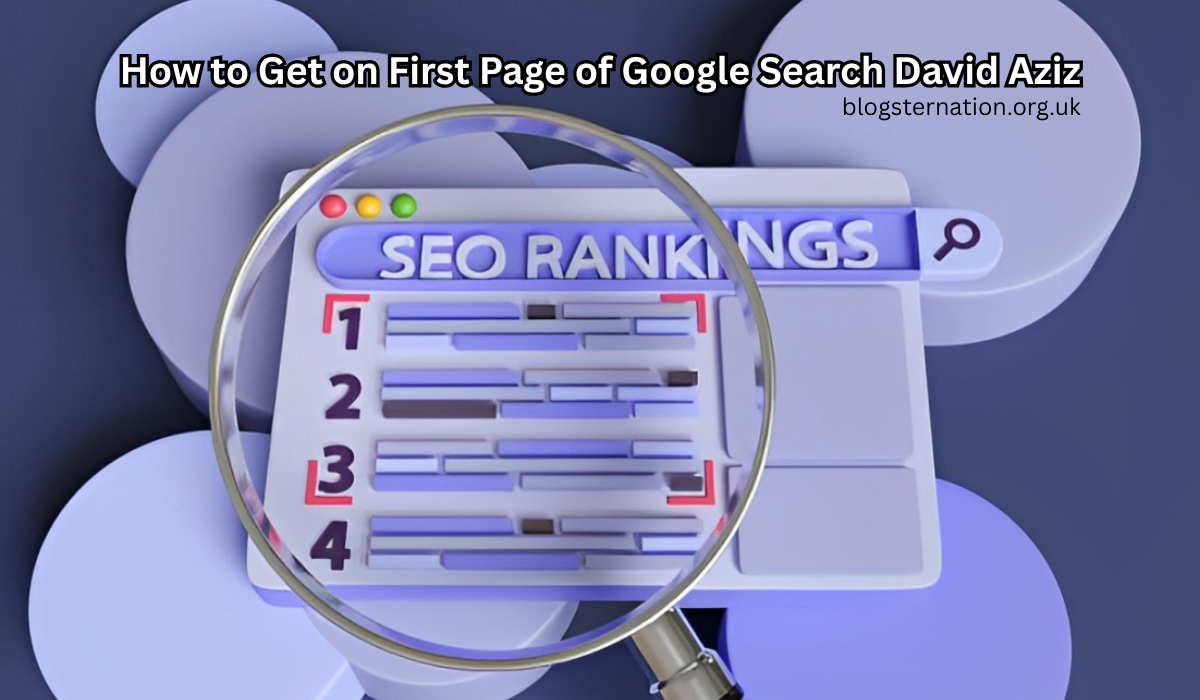How to Get on First Page of Google Search David Aziz
How to Get on First Page of Google Search David Aziz. This easy guide will show you how David Aziz can improve his online visibility with simple SEO tips.
Introduction
In today’s online world, everyone wants to be on the first page of Google search results. Whether you’re a business owner, a blogger, or someone like David Aziz, getting to the first page can make a huge difference. It can help you get noticed, build trust, and grow your audience. This article will explain, in simple terms, how David Aziz can get on the first page of Google. We’ll walk through easy-to-follow steps, from choosing the right keywords to making your website better for search engines.
Step 1: Choose the Right Keywords
The first step to ranking on Google is picking the right keywords. Keywords are the words or phrases people type into Google when they search for something. For example, if someone is searching for how to get more traffic to their website, they might type in “how to get on first page of Google search.” If David Aziz wants to rank for that phrase, he needs to make sure it’s in the content on his website. You can use tools like Google Keyword Planner or Ubersuggest to find popular keywords related to your topic. Once you have your keywords, use them naturally in your articles, blog posts, or product descriptions.
Step 2: Create High-Quality Content
Once you know which keywords to target, it’s time to focus on your content. Google loves high-quality, helpful, and informative content. When creating content, think about what your audience wants to know and how you can provide value. For example, if David Aziz is trying to rank for “how to get on first page of Google search,” he should write an article that explains exactly how to do that. The content should be clear, easy to understand, and offer practical tips. Google rewards websites that provide helpful information to their users, so make sure your content answers the questions people are asking.
Step 3: Optimize Your Website for SEO
SEO stands for Search Engine Optimization. It’s the process of making your website easy for Google to understand. There are a few things you can do to improve your website’s SEO:
-
Title Tags: Make sure your title tags (the title of each page) are clear and include your keywords.
-
Meta Descriptions: Write short descriptions (under 160 characters) of your pages. These should also include your keywords.
-
Headings: Use headings (H1, H2, H3) to organize your content. Include your keywords in some of these headings.
-
Alt Text for Images: When you add images to your site, include a short description of each image in the alt text. This helps Google understand what the image is about.

Step 4: Improve Your Website’s Speed
Nobody likes a slow website. Google doesn’t like it either. If your website takes too long to load, visitors will leave before they even get a chance to see your content. This can hurt your ranking. To fix this, make sure your website is as fast as possible. You can use tools like Google PageSpeed Insights to check how fast your website is. Some simple things to improve speed include reducing the size of images, removing unnecessary plugins, and using a reliable web hosting service.
Step 5: Get Backlinks
Backlinks are links from other websites that point to your site. Google sees backlinks as a sign that your website is trustworthy and useful. The more backlinks you have from good, high-quality websites, the better your chances are of ranking higher on Google. To get backlinks, you can:
-
Guest Post: Write articles for other websites in your niche and include links back to your site.
-
Ask for Links: Reach out to websites or blogs that you trust and ask them to link to your content.
-
Create Shareable Content: When you create valuable and interesting content, other websites may link to it naturally.
Step 6: Make Your Website Mobile-Friendly
A lot of people browse the internet on their phones. If your website doesn’t work well on mobile devices, Google will rank it lower. Make sure your website is mobile-friendly by choosing a responsive design. This means your website will look great on both desktops and mobile devices. You can use Google’s Mobile-Friendly Test to check how well your site works on mobile.
Step 7: Use Social Media to Promote Your Content
Social media can help bring more people to your website, which can help improve your Google ranking. Share your content on platforms like Facebook, Instagram, Twitter, and LinkedIn. The more people who engage with your content, the more likely it is that Google will notice your site and rank it higher. Don’t forget to interact with your followers and encourage them to share your posts.
Step 8: Focus on User Experience
User experience (UX) refers to how easy and pleasant your website is to use. Google cares about how people interact with your site. If visitors spend a lot of time on your site and visit several pages, Google will see that as a sign that your site is good. Here are a few ways to improve UX:
-
Make sure your website is easy to navigate.
-
Use clear and simple language.
-
Avoid pop-ups or anything that annoys visitors.
Step 9: Local SEO – Rank in Local Search Results
If you have a local business, it’s important to optimize your website for local search. Local SEO helps you show up in Google’s local search results, which is especially helpful if you want to attract customers in your area. Start by setting up a Google My Business profile. This free tool lets you manage how your business appears on Google Search and Maps. Be sure to add your business name, address, phone number, and website. You can also encourage customers to leave reviews, which can help boost your local rankings.
Step 10: Keep Track of Your Progress
Once you’ve implemented these strategies, it’s important to track your progress. Use tools like Google Analytics and Google Search Console to monitor how well your website is performing. You can see how many people are visiting your site, which keywords are driving traffic, and which pages are the most popular. If something isn’t working, you can make changes to improve it. SEO is an ongoing process, so keep testing and tweaking your strategies to get the best results.

Conclusion
Getting on the first page of Google search results may seem like a big challenge, but with the right approach, anyone can do it. By choosing the right keywords, creating high-quality content, optimizing your website, and building backlinks, you can improve your chances of ranking higher. Remember to focus on user experience and local SEO if that applies to you. Keep track of your progress and make adjustments along the way. With time and effort, David Aziz can achieve his goal of ranking on the first page of Google.
Read also: Abithelp Tablets A Comprehensive Guide to Better Health







